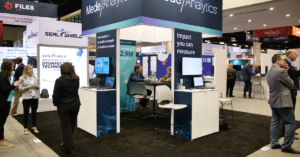With the first half of the year behind us, we thought we’d share some of the current healthcare trends that are gaining traction in this week’s blog post. We’ve outlined the top four to keep watch for over the remainder of 2018.
Revenue Cycle Management – Providers recognize the need for more efficient revenue cycle management (RCM) operations to collect payment for services. Implementing RCM technology can help organizations automate this process. In fact, Health Data Management recently named MedeAnalytics to its list of 20 leading revenue cycle management vendors.
In our blog post by Tom Schaal, director of product management, he outlines the need for healthcare organizations to prioritize and develop a RCM strategy that addresses cash collections, bad debt, denials, productivity and what providers should look for in an analytics partner.
Artificial Intelligence – AI is still top of mind and according to research from Accenture, healthcare’s AI market could increase to $6.6 billion by 2021. Many executives think it could take over some clinical tasks, leaving providers with more time to focus on patients. Google is dominating this space in healthcare by debuting its Google Duplex and developing ways for machines to diagnose patients – much like a physician would do.
But staying ahead of the of AI curve can be challenging. Our blog post from Tyler Downs, chief technology officer, offers advice for healthcare organizations to achieve success, like adopting security applications and making sure they have the right team to develop AI.
Prescriptions to Your Door – Amazon has been making headlines in the past few months, from choosing its new CEO for its mega-merger with JP Morgan and Berkshire Hathaway to announcing its plans to purchase PillPack which offers presorted medication and home delivery. Could PillPack soon be a part of the Amazon Prime membership? It’s possible that prescriptions will quickly be delivered in a cost-effective way right to your doorstep.
Doctors Embracing Consumer Membership Fees – Growing patient and physician frustrations around healthcare costs have led to the rise of doctors embracing their own membership fees. In lieu of working with payers under the traditional structure, physicians across the country are opting for a membership model where patients pay these monthly membership fees for their services.
According to a direct primary care physician, there could be as many as 800 direct primary care practices across the U.S., which could increase in the next few years if healthcare costs continue to rise.
Bottom line: the healthcare landscape is always changing, and organizations need to stay on top of trends. MedeAnalytics partners with clients to help them solve these ever-changing challenges. To learn more about how we can help you, contact us here.
Get our take on industry trends
Optimizing opportunity in value-based care
Our own Dave Schweppe (Chief Analytics Officer) and David Wolf (AVP, Payer Solutions) sat down with Todd Sauers, Manager of…
Read on...Expert Q&A: The HEDIS details all health plans need to know
With HEDIS certification season quickly approaching, we sat down with MedeAnalytics experts Melissa Linder, Director of Product Management, and Lori…
Read on...Looking back at HIMSS22
Our MedeAnalytics team was thrilled to be back in person for this year’s HIMSS event, after a two-year hiatus due…
Read on...A look ahead at payer analytics innovation
Pioneering payers know that building a strong foundation is the key to enacting sustainable innovation. This foundation typically includes the…
Read on...


